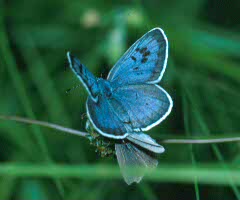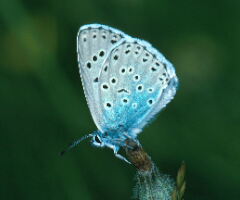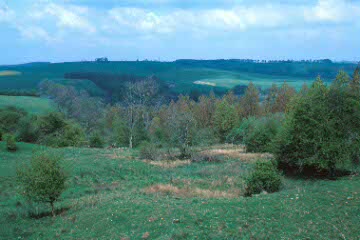Large Blue
Maculinea arion

| Home | <The Butterflies of Gloucestershire | Species | Habitats | Conservation |
Large BlueMaculinea arion |
 |
 |
| Female, 20 June 1993 | Male, 20 June 1993 |
Habitat
Large Blue requires short-turf sites with the initial larval foodplant
Thyme, and a high density of nests of the red ant Myrmica sabuleti.
The young larvae are carried into the ant nests where they feed on ant
grubs.
| This grassland site was figured in E B Ford's book on butterflies in the Collins New Naturalist series. It may have had a Large Blue colony when that book was published in 1945, but the grassland is no longer suitable. |  |
Conservation Issues
The British race of Large Blues became extinct in 1979 when the last
Devon colony died out. The last known Cotswold colony apparently died
out about two years before then as a result of the summer
drought of 1976. Its survival until then had been a well-kept secret,
and several published accounts suggested the species had been lost
from the Cotswolds much earlier.
Reintroductions were made to several former British sites during the 1990s including three Cotswold valleys. Whilst some of the other sites have been very successful, the first two Cotswold reintroductions have not. One reason may be a timing mis-match between the butterfly's emergence and the flowering of thyme. Unfavourable weather during the flight period has also been a problem.
The third Cotswold reintroduction attempt was made in 1999. Its outcome is also in doubt, because it is now thought that the former Cotswold race may have had a 2-year life-cycle (which could explain why it tended to emerge a bit earlier here than at warmer sites in Devon and Cornwall). The stock reintroduced to Britain are from a Scandinavian location where they have a 1-year life-cycle. A different source with a 2-year life-cycle might be necessary for a Cotswold reintroduction to be successful in the long term.
In spite of its protected status, the species is at risk from collectors and other butterfly enthusiasts. On one Cotswold grassland in the early summer it was found that many stones embedded in the surface had been lifted and overturned, perhaps by someone hoping to find a Large Blue pupa. Numerous ant nests were exposed and abandoned by the ants as a result of this.